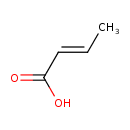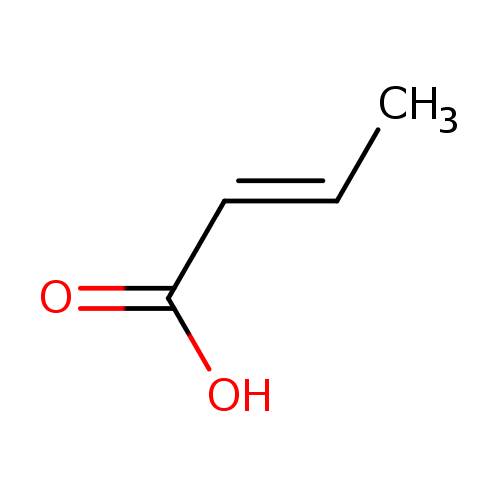|
Record Information |
|---|
| Version |
1.0 |
|---|
| Update Date |
1/22/2018 11:54:54 AM |
|---|
|
Metabolite ID | PAMDB120144 |
|---|
|
Identification |
|---|
| Name: |
crotonate |
|---|
| Description: | The conjugate base of crotonic acid; used by some bacterial species as a carbon and energy source. |
|---|
|
Structure |
|
|---|
| Synonyms: | - (2E)-2-butenoate
- (2E)-2-butenoate
- (E)-2-butenoate
- (E)-crotonate
- 2-butenoate
- 3-methylacrylate
- α-butenoate
- α-crotonate
- β-methacrylate
- β-methylacrylate
- trans-2-butenoate
- trans-crotonate
|
|---|
|
Chemical Formula: |
C4H5O2 |
|---|
| Average Molecular Weight: |
85.082 |
|---|
| Monoisotopic Molecular
Weight: |
86.03678 |
|---|
| InChI Key: |
LDHQCZJRKDOVOX-NSCUHMNNSA-M |
|---|
| InChI: | InChI=1S/C4H6O2/c1-2-3-4(5)6/h2-3H,1H3,(H,5,6)/p-1/b3-2+ |
|---|
| CAS
number: |
3724-65-0 |
|---|
| IUPAC Name: | (2E)-but-2-enoate |
|---|
|
Traditional IUPAC Name: |
butenoic acid |
|---|
| SMILES: | CC=CC(=O)[O-] |
|---|
|
Chemical Taxonomy |
|---|
|
Taxonomy Description | This compound belongs to the class of organic compounds known as straight chain fatty acids. These are fatty acids with a straight aliphatic chain. |
|---|
|
Kingdom |
Organic compounds |
|---|
| Super Class | Lipids and lipid-like molecules |
|---|
|
Class |
Fatty Acyls |
|---|
| Sub Class | Fatty acids and conjugates |
|---|
|
Direct Parent |
Straight chain fatty acids |
|---|
| Alternative Parents |
|
|---|
| Substituents |
- Unsaturated fatty acid
- Straight chain fatty acid
- Monocarboxylic acid or derivatives
- Carboxylic acid
- Carboxylic acid derivative
- Organic oxygen compound
- Organic oxide
- Hydrocarbon derivative
- Organooxygen compound
- Carbonyl group
- Aliphatic acyclic compound
|
|---|
| Molecular Framework |
Aliphatic acyclic compounds |
|---|
| External Descriptors |
|
|---|
|
Physical Properties |
|---|
| State: |
Solid |
|---|
| Charge: | -1 |
|---|
|
Melting point: |
72 °C |
|---|
| Experimental Properties: |
| Property | Value | Reference |
|---|
| Melting Point | 72 °C | Not Available | | Boiling Point | Not Available | Not Available | | Water Solubility | Not Available | Not Available | | LogP | 0.72 | HANSCH,C ET AL. (1995) |
|
|---|
| Predicted Properties |
|
|---|
|
Biological Properties |
|---|
| Cellular Locations: |
Not Available |
|---|
| Reactions: | |
|---|
|
Pathways: |
Not Available |
|---|
|
Spectra |
|---|
| Spectra: |
|
|---|
|
References |
|---|
| References: |
- Auburger G, Winter J (1996)Activation and degradation of benzoate, 3-phenylpropionate and crotonate by Syntrophus buswellii strain GA. Evidence for electron-transport phosphorylation during crotonate respiration. Applied microbiology and biotechnology 44, Pubmed: 8867639
- Bader J, GŁnther H, Schleicher E, Simon H, Pohl S, Mannheim W (1980)Utilization of (E)-2-butenoate (crotonate) by Clostridium kluyveri and some other Clostridium species. Archives of microbiology 125, Pubmed: 7387331
|
|---|
| Synthesis Reference: |
Not Available |
|---|
| Material Safety Data Sheet (MSDS) |
Not Available |
|---|
|
Links |
|---|
| External Links: |
|
|---|


